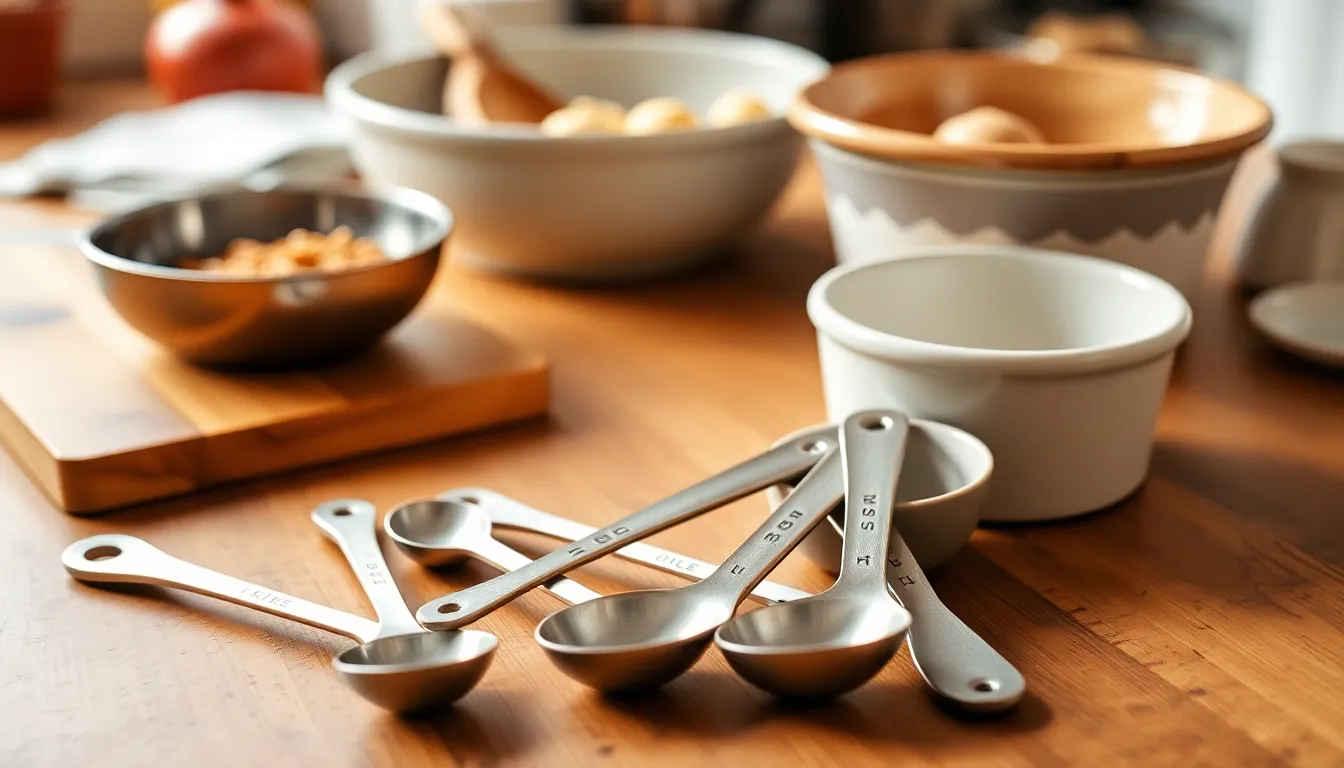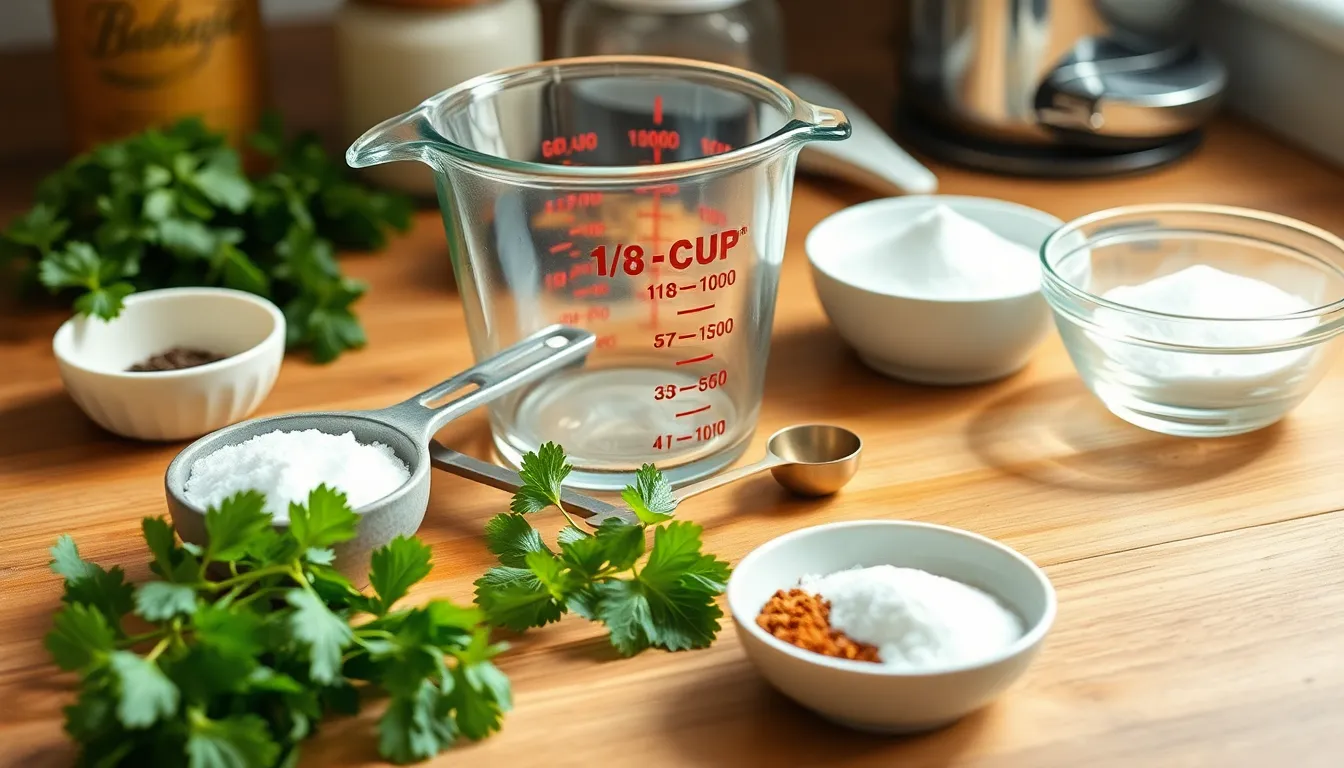Measuring ingredients can feel like a game of math, especially when you’re trying to convert 1/8 cup to teaspoons. Who knew baking could double as a math lesson? But don’t worry, this isn’t rocket science—it’s just a sprinkle of precision in the kitchen.
Table of Contents
ToggleUnderstanding Measurement Conversions
Measurement conversions play a crucial role in cooking and baking. Converting between different units ensures precision, leading to better results in the kitchen. One common conversion involves 1/8 cup to teaspoons. This specific conversion helps home cooks and professional chefs alike.
To clarify, 1 cup equals 48 teaspoons. Thus, when converting 1/8 cup, the calculation becomes straightforward. Multiplying 1/8 by 48 yields 6 teaspoons. Knowing this conversion makes it easier to adjust recipes or scale them according to personal needs.
In the context of baking, small differences can significantly affect the outcome of a dish. A precise measurement, like knowing that 1/8 cup translates to 6 teaspoons, can determine whether a cake rises perfectly or not. Following these conversions aids in achieving consistent results across various recipes.
Using conversion tools can streamline this process. Many online calculators allow users to input units and receive swift results, ensuring accuracy. While technology simplifies conversions, having the fundamental knowledge of common measurements remains valuable.
Understanding these measurements helps one navigate recipes confidently. Familiarity with conversions like 1/8 cup to teaspoons leads to enhanced cooking skills. With practice and attention to measurements, anyone can master the art of accurate ingredient proportions.
The Basics of Cups and Teaspoons

Understanding cups and teaspoons is essential for accurate ingredient measurement in cooking and baking. Precise measurements ensure consistent and successful results.
Definition of a Cup
A cup is a standard unit of measurement commonly used in cooking. This unit measures volume and varies slightly in size based on the region but generally holds about 8 fluid ounces. In baking, a cup helps gauge dry and liquid ingredients and allows for easy recipe scaling. When converting larger quantities, cooks often rely on the cup’s equivalency to ensure accuracy. One cup equals 48 teaspoons, providing a reliable way to achieve desired proportions, thus minimising the potential for error.
Definition of a Teaspoon
A teaspoon is another vital measurement unit, primarily used for smaller quantities. It typically represents about 5 milliliters in volume. Understanding the teaspoon’s role in recipes helps maintain balance and flavor. Teaspoons are often used for both dry and liquid ingredients, enhancing precision in dishes like sauces or baked goods. Accurate use of teaspoons can significantly impact the final taste, texture, and consistency of recipes, making them an invaluable tool in any kitchen.
Converting 1/8 Cup to Teaspoons
Converting 1/8 cup to teaspoons is straightforward. This measurement equates to 6 teaspoons, which simplifies the process in recipes requiring precise ingredient amounts.
Calculation Method
To calculate the conversion, know that 1 cup equals 48 teaspoons. By dividing 48 by 8, the value per cup is determined as 6 teaspoons. Since 1/8 cup represents one-eighth of this total, it naturally follows that the result is 6. This quick calculation helps maintain consistency in various cooking or baking tasks.
Practical Examples
For practical understanding, consider a recipe requiring 1/8 cup of sugar. By using 6 teaspoons, the desired sweetness is achieved without miscalculating. When adjusting a recipe that calls for 1/2 cup of flour, breaking it down into smaller portions may necessitate this conversion; thus, 1/8 cup translates into 6 teaspoons for accurate measurement. In sauces or dressings, precise adjustments are crucial, making this conversion essential for achieving balanced flavors.
Common Uses in Cooking and Baking
1/8 cup, equating to 6 teaspoons, finds frequent application in both cooking and baking. Recipes often require this measurement for precise seasoning. For instance, adding 1/8 cup of dry herbs enhances flavor without overpowering a dish.
Baking recipes often specify 1/8 cup for sugar, critical in desserts like cookies and cakes. Accurate measurements prevent inconsistencies, ensuring delightful textures and tastes. A precise amount of sugar contributes to browning and moistness.
Salad dressings commonly utilize 1/8 cup of vinegar or oil, equating to 6 teaspoons. This balance enhances flavor without being too acidic or oily. Many dressings require this measurement to maintain a harmonious taste profile.
In sauces, 1/8 cup serves as a base measurement for ingredients like soy sauce or mustard. Modifying recipes to include this measurement ensures dish integrity. Chefs can tweak flavors without losing the intended taste balance.
This measurement also appears in small batch cooking. When preparing smaller amounts of dishes, using 1/8 cup maintains consistency, making it easier to replicate favorites. Whether creating a quick sauce or seasoning a small portion, precise measurements facilitate success.
Experiments in the kitchen often lead to new flavors. Understanding how to measure and convert ensures experiments stay within the desired flavor range. Mastering the use of 1/8 cup simplifies the cooking and baking process, providing a foundation for culinary creativity.
Mastering the conversion of 1/8 cup to teaspoons is a key skill for anyone looking to improve their cooking and baking. Understanding that 1/8 cup equals 6 teaspoons allows for precise ingredient measurements which can elevate the quality of dishes. This knowledge not only aids in recipe adjustments but also ensures consistent flavor and texture in culinary creations.
With practice and attention to detail, anyone can navigate measurement conversions with confidence. Embracing this foundational skill opens the door to greater culinary exploration and success in the kitchen.



